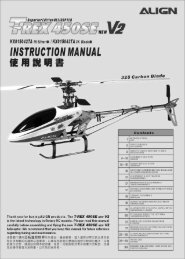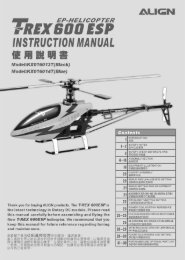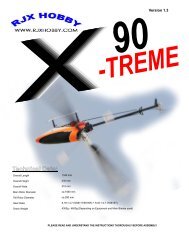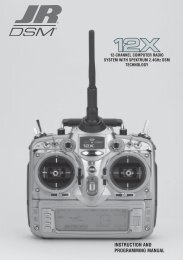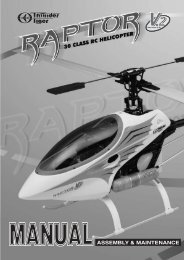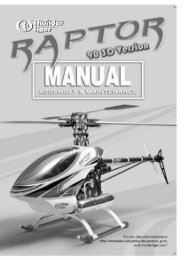TDR-Manual 2009 - Henseleit Helicopters
TDR-Manual 2009 - Henseleit Helicopters
TDR-Manual 2009 - Henseleit Helicopters
You also want an ePaper? Increase the reach of your titles
YUMPU automatically turns print PDFs into web optimized ePapers that Google loves.
Adjustment of the throttle curves and the motor:At first programm your controller in the correct mode according to the instructions of the manufacturer (Mode 4 at the Jivecontroller).Attention! If the helicopter had the same starting behaviour as a car or a boat the wrong mode would be fatal.If the rotor does not rotate when starting the engine, you have to exchange two cables from the controller to the engine.There are two ways to drive the controller. The Jazz controller works excellently. You provide a RPM via a free channel usinga slider switch or via the throttle channel and already programmed values that are retrieved from different flight attitudes. Thecontroller keeps the values constant in spite of different strains. This certainly is only possible as long as the engine is able tomaintain the RPM.If you follow my instructions and standard configurations, the engine can manage 13° pitch with nearly 1850 RPM, i.e. thecontroller ensures constant RPM up to these values. Therefore it is not reasonable to adjust higher RPM that is reached bythe engine at low load but cannot be kept in the case of required performances. This would result in permanent RPMvariations and the system becomes nervous.When using a slider switch for the controller every RPM between about 1300 up to about 2000 RPM can infinitely beadjusted. However, it is difficult to adjust a certain RPM during which the helicopter can be flown particularly well and toimmediately combine it with the corresponding gyro sensitivity. My gyro sensitivity is between 95% during speed-flight and120% during low RPM for hovering. It is obvious, that you can increase the gyro performance with an adjustable sensitivity forlower RPM. At a fixed value the maximum value of the gyro sensitivity is limited by the ascending behaviour during highspeedflight with the highest RPM.That is why I connected the controller to the throttle channel and programmed 4 different flight conditions + auto-rotation withdifferent throttle curves (in fact, they are straight lines).Caution! The given values in the table can be used for the set-up with the Pyro 30-12 Motor (13 teeth –pinion) as well as theKontronik Jive 80+HV controller and a new 12S LiPo Pack (SLS).In the diagram you can find my programmed RPM with the corresponding rates. Five straight lines have been programmed,so that the controller gets a constant input signal independent of the pitch stick position and controls the corresponding RPMitself. Depending on the transmitter the values may differ, but they serve very well as initial values (full throttle RPM 100% isattainable only with 0° pitch and is usually not used during the flight).Attention! Unfortunately the RPM given by the Jive controller depend to a geat extent on the charge condition or the quality ofthe battery when being connected. Thus, the adjusted curves when connecting a new, fresh battery do not guarantee that theRPM are still correct after 20 flights with the same battery. With the increasing number of cycles or when using differentbatteries the RPM vary. So it is reasonable to adjust them from time to time.For every RPM I have adjusted the gyro sensitivity such that the helicopter flies smoothly during fast forward flights. Bymeans of a slider switch the sensitivity, i.e. the programmed maximum value, can slightly be reduced if necessary. Whenswitching from higher to lower RPM the gyro may get over-controlled for a moment.Attention! Do not let the engine without blades run at a throttle specification of more than about 40%. If there is not any loaddue to the rotor the RPM values do not correspond with the values adjusted under load, i. e. the engine runs too high whichmay result in a damaged mechanics.Generally don´t fly with rotor rpm´s from over 1900 revs/min because our flight tests has showen that you won´t get moreperformance or speed only rising the energy consumption dramaticly.Another point is that specially with not well balanced tail blades the aluminium tail boom will come into resonance vibrationswhich you can hear by a drone noise coming up.If this sound appear reduce the rotor speed immediately to avoid any damage.50




